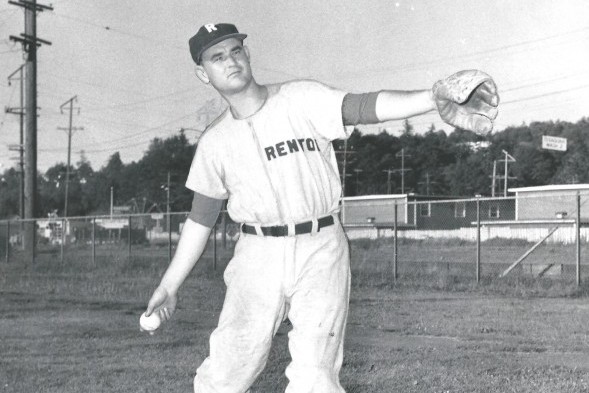
By David Eskenazi and Steve Rudman
Not much excites a baseball fan more than the debut of a cant-miss prospect, especially when the prospect is a young flamethrower on the order of the one the Seattle Rainiers touted excitedly in a news release Aug. 9, 1955.
This youngster, Rainiers officials trumpeted, has developed four pitches a sinker, a screwball, a sweeping curve, and a breaking ball that he secretly refers to as his Atomic Pitch.
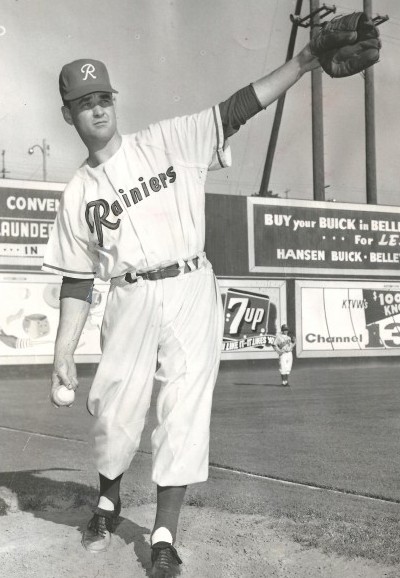
Its unlike anything youll see in baseball today, enthused Rainiers manager Fred Hutchinson, the franchise icon who pitched in the major leagues for more than a decade. This young man has a chance to become something very special.
Hutchinson could personally attest to the prospects prowess. Stepping in himself against the young man in a Sicks Stadium workout, Hutchinson, noted for his own hitting ability, couldnt get his bat on the ball not so much as a foul tip, and not even when Hutchinson attempted to bunt. Throwing only four pitches, three for strikes, the young prospect rang up Hutchinson in a matter of seconds.
The kid is amazing, Rainiers general manager Dewey Soriano said. Every pitch he throws does something. None of his pitches is straight or true. Hes got something on every pitch. He really has great stuff.
Little wonder, then, that 13,999 curiosity seekers nearly triple the average attendance for a 1955 Rainiers game — jammed Sicks Stadium Aug. 10, 1955, to watch 25-year-old Robert Clelland Fesler make his Pacific Coast League debut in the first game of a doubleheader against the San Francisco Seals.
Naturally, the game was heavily hyped by the local media, and fans packed Sicks Stadium to cheer on their new pitching phenom, Seattle Times columnist Don Duncan reported. The Rainiers were in the midst of a pennant battle and every game was important.
For more than 10 minutes, San Franciscos leadoff hitter, Jimmy Moran, stood near the on-deck circle watching Feslers blazing warmup throws, described by The Times as rifle bullets.
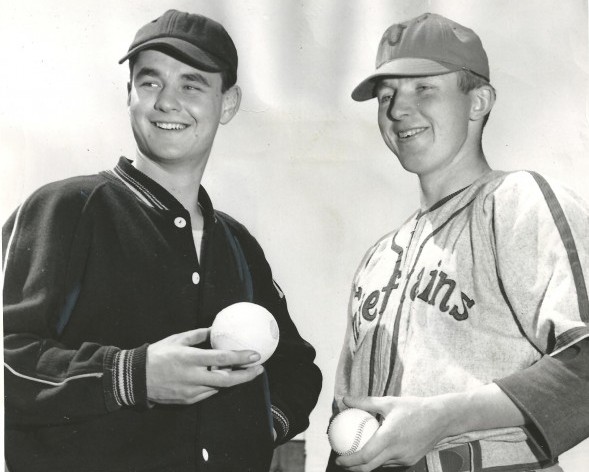
Finally, Moran came to the plate, the Seattle Post-Intelligencer reported. Moran stood nervously, like a man awaiting execution. Three pitches and he went down swinging. The fans went wild, roaring their approval, certain they were witnessing history, the first of another Walter Johnson or Bob Feller.
In the absence of the still-to-be-invented radar gun, The Times calculated that Feslers pitches had to be 95 mph. The P-I opted for more colorful imagery: His pitches are faster than youve ever driven your car.
No one at Sicks Stadium that day ever witnessed anything remotely close to Feslers brief but memorable confrontation with Moran, because Fesler smoked all three blurs past the flailing Oakland native . . . UNDERHANDED.
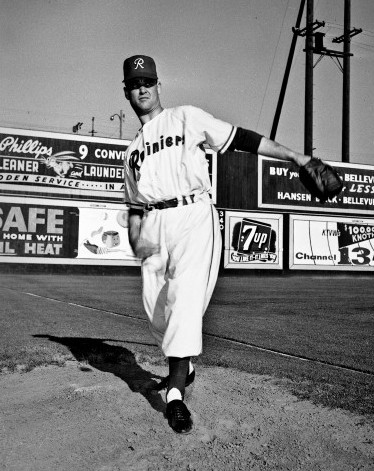
Bobby Fesler grew up in a pre-Space Needle Seattle that would, at least from an athletic point of view, be unrecognizable today. The city had no professional sports except the Rainiers, not even the Lake Washington hydroplane races, still some years away.
The Times and P-I published several pages of sports news daily, routinely packaging the results of various local amateur competitions adjacent to stories on the Rainiers and the University of Washington football and basketball teams.
In winter, the newspapers jammed the front sports pages with recaps and results from dozens of bowling leagues, youth basketball and ski races. In summer, those sports ceded print space to swimming, tennis, archery and softball — especially softball, because there was a lot of it junior leagues, major leagues, old-timer leagues and womens leagues.
Virtually every amateur league, and most amateur teams, represented a commercial sponsor, major ones such Boeing and Federal Old Line Insurance on the high end, and smaller-profile taverns, restaurants, barber shops, hardware stores, tire dealers, etc. on the other end.
Unlike newspaper readers today (those few who remain), those of that era would not have been surprised to find Pops Tavern, Smittys Used Tires and Dog House line scores published not far from a Rainiers box score on the first sports page.
In the 1930s and 40s, no one had a rep bigger in Seattles industrial softball leagues than Tony Fesler, frequently described in the papers as a legend. It was Tony, an ace pitcher, who drew son Bobby into the sport.
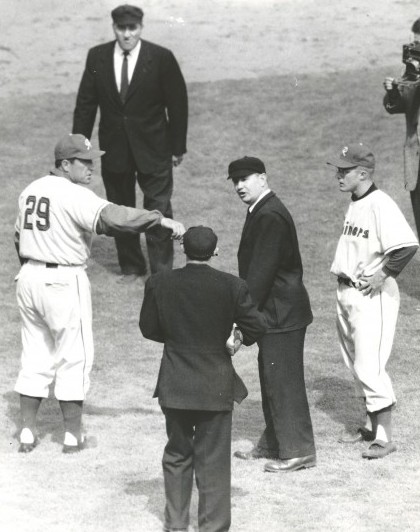
Bobby played first base as a kid and pitched for the first time in a James Madison Junior High intramural baseball game.
Like Hutchinson, his future manager, Fesler attended Franklin High School, where he didnt show much as an outfield candidate.
Influenced by father Tony, Fesler gravitated to softball in 1945, pitching first in The Seattle Times Carrier League, and later in various city leagues sponsored by the Seattle Parks Department.
He fanned grown men before he began shaving, Duncan wrote in The Times.
In 1947, a year in which Tony outdueled a young, but already-famous Walla Walla native named Eddie Feigner, the king of all softball, Tony and Bobby pitched together for the first time, for a team sponsored by Mallory Transfer & Storage.
Bobby established his own brand of dominance after enrolling at Seattle University, which entered a team in the Northwest AA Softball League, the top industrial circuit in a city that also featured the American A League, Boeing National League, Evergreen League and the West Seattle Businessmen’s League.
The Northwest AA League included the Skyroom Rippers (tavern), Georgetown Merchants, Fremont Merchants, Fuel Oil Dealers, Renton Central Tavern, Faber Hardware and Federal Old Line Insurance, and played its games at a variety of sites, including White Center, Lower Woodland Playfield and Broadway Playfield.
Bobby Fesler’s specialty became the eye-popping result.
Fesler became known as the ‘King of the Softball Pitchers,’ Duncan wrote. Although the moniker wasnt terribly creative, Fesler was something special. He not only had the fastest fastball, but he had six varieties of curve ball. He made opposing batters in his leagues look foolish at the plate.
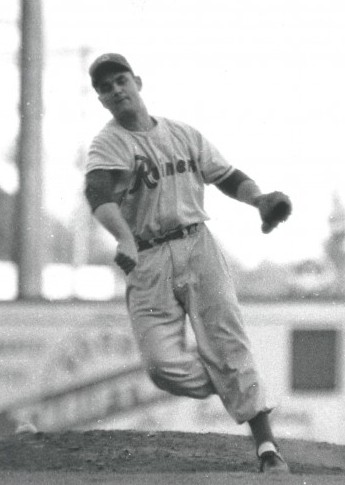
A Fesler sampling leading up to his much-ballyhooed debut with the Seattle Rainiers:
- May 26, 1949: Pitching for Seattle University, fanned 24 batters, 14 in a row, in a 3-0 victory over a team representing the Sand Point Naval Air Station.
- July 28, 1949: Hurled a near-perfect game, fanning 20 of the 21 men he faced in Seattle U.s 1-0 victory in the Metropolitan Softball Tournament over Nite Cap (a tavern).
- June 5, 1952: Fanned 14, allowing only four hits, in a 2-0 win over the Fremont Merchants.
- June 23, 1952: Pitched and batted Seattle U. to a doubleheader win over Pops Inn of Bremerton; won the first game by throwing a no-hitter with 17 strikeouts, and smashed a game-winning homer in the 3-2 nightcap.
- Aug. 26, 1952: Struck out 15 batters in a 2-1 Seattle U. victory over the Renton Cowboys.
- Aug. 20, 1954: Threw an 11-inning no-hitter over Players Tavern, striking out 26 of a possible 33.
- Aug. 26, 1954: Whiffed 17 of the 21 batters he faced in a 4-0 victory over the Beacon Hill Merchants.
One time, Duncan wrote, Fesler fanned 26 in a nine-inning game and the 27th man popped out to the catcher. In that game, one of the batters fouled off a pitch in the third inning, and the spectators stood and clapped.
Fesler was so successful that he considered himself a failure any time he didnt pitch a no-hitter. As they say around the locker rooms, he threw aspirin tablets. Batters cant hit what they cant see.
Several times he tossed four softball games in a day. Once, pitching for the Happy Hour Tavern in a tournament, he started the day with a four-hitter, then pitched a no-hitter and added a perfect game before fading to a two-hitter.
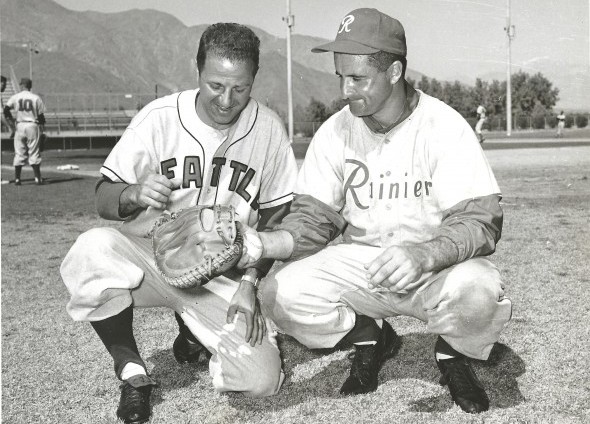
“Once, during a road trip to Victoria, he struck out 24 batters the first day and 26 of 27 the second.
You change shirts, have a cigarette and go back on the hill, Fesler told Duncan.
The 1954 Seattle Rainiers didnt have much to recommend them. En route to a fifth-place finish under manager Jerry Priddy, who would give way to Hutchinson in 1955, the Rainiers lagged as an afterthought on the local athletic landscape, their attendance miserable.
In an attempt to get the turnstiles spinning, the Rainiers asked the 24-year-old Fesler to participate in a pre-game show before a Sicks Stadium game against the Hollywood Stars.
Fesler, who joined the Renton Cowboys after Seattle U. dropped softball, accepted, saying, Baseball hitters are highly overrated. These guys wont get a loud foul off my offerings.
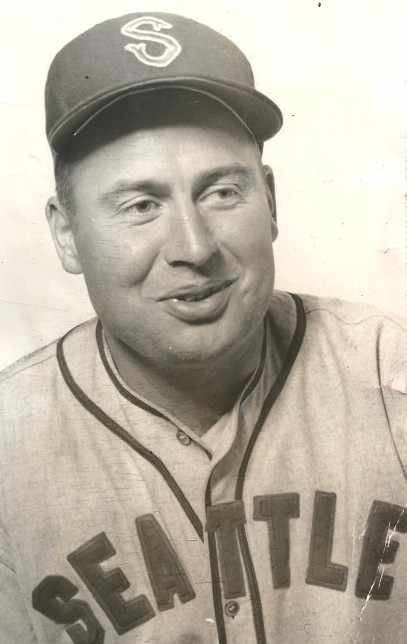
Fesler explained that his underhand delivery is the natural arm movement, which enabled his breed to make hash of the actuarial tables that governed overhand throwers. Softballs, Fesler said, could be thrown to upshot, drop, curve or break.
The Rainiers selected June 23, 1954 for Feslers showdown against batters from the Rainiers and Stars, stating in a press release, Nine batters assembled from both the home and visiting teams will attempt to solve Feslers tricky assortment, which has reaped for him more than 50 no-hitters. Fesler will pitch from the regulation, 46-foot softball distance.
Fesler proved as good as advertised, whiffing eight of the nine batters who faced him and plunking the other one, Hollywood manager Bobby Bragan, on the ankle.
With 4,281 curiosity seekers in attendance, Fesler threw 28 pitches, 25 for strikes. Only Bragan touched the ball, and all he managed was a foul tip. Fesler modestly said afterward that he did not bear down to the full extent of his remarkable capabilities.
Seattle Post-Intelligencer columnist Royal Brougham thought so much of Feslers performance that the softball ace became a 1954 Man of the Year (now Star of the Year) nominee.
Hutchinson, then managing the Detroit Tigers, knew nothing of all this until he became the manager of the Rainiers a year later. But Hutchinson soon got wind of Fesler after hearing these stories:
- June 6, 1955: Fanned 32 in 12 innings in a 4-1, 12-inning Federal Old Line win over Bens Truck Parts of Tacoma.
- June 21, 1955: Pitched a no-hitter, striking out 14, in a 1-0 Federal Old Line win over the Coffee Pot Cafe.
- July 17, 1955: Threw a no-hitter, fanning 12, in a 1-0 win over Fuel Dealers of Vancouver, WA.
- July 22, 1955: Struck out 33 in a 14-inning, 3-1 win over Ben’s Truck Parts of Tacoma.
By mid-summer, 1955, four teams — Rainiers, Stars, San Diego Padres and Los Angeles Angels — had a chance to win the pennant, only three games separating the first-place Rainiers from the fourth-place Angels.
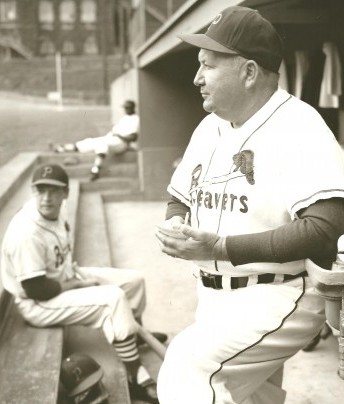
Hutchinson, in the process of running a remarkable 64 players through his roster, sought every advantage at his disposal, even if that meant trying out a softball pitcher.
So Hutchinson summoned Fesler to throw against a lineup of Rainiers and Sacramento Solons hitters during batting practice. Result: Both clubs found Fesler overpowering, bewildering and unhittable.
Fesler faced 11 batters from the 46-foot softball distance. With his windmill underhand motion, he fanned them all, including Hutchinson, who couldnt get his bat on the ball. Hutchinson promptly offered Fesler a contract.
To make room for Fesler on the roster, Hutchinson returned pitcher Van Fletcher, who spent parts of the 1952 and 1954 seasons with the Rainiers, to the Detroit Tigers, who had optioned him to the Rainiers the previous June.
Fesler, 25, not only will be pitching from the standard 60 feet, six-inch mound, the Rainiers said after Fesler signed his PCL contract, but he will (team’s capital letters) PITCH UNDERHANDED IN EXACTLY THE SAME MANNER THAT HAS PUSHED HIM TO THE TOP RUNGS OF SOFTBALL.
This is not a publicity stunt, Hutchinson insisted. Bobby has an excellent chance in baseball, but he needs plenty of work. Before he takes the mound, we will be sure that he is ready for the Pacific Coast League competition.
Fesler spent several days at Sicks Stadium throwing under the guidance of former Rainiers ace Kewpie Dick Barrett, with Ray Orteig catching and Soriano looking on, wide of eye.
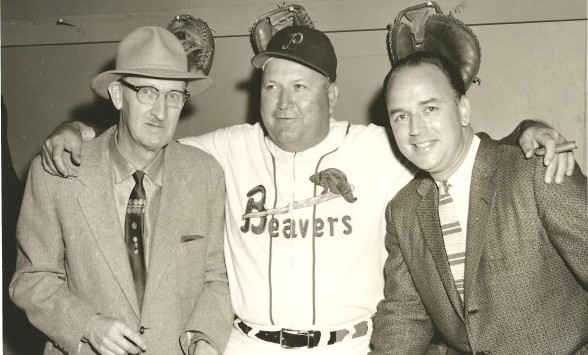
When Hutchinson mentioned that Fesler needed work to succeed at the PCL level, he meant that Fesler had to master the intricacies of the balk rule, which did not exist in softball, that he had to work on fielding and covering bases, how to assume a position on the mound with men on base, and how to throw to bases to pick off a runner.
How he will make out in baseball is a question, said Soriano, but there is no doubt about his ability in softball. He has participated in three national tournaments, winning numerous Most Valuable Player awards and being placed on several all-star teams. Fesler doesnt know how many no-hit games he has hurled, but he estimates then number to be about 55.
The Rainiers declared Fesler ready to go Aug. 10, penciling him in as the starting pitcher in the first game of a twin bill against San Francisco.
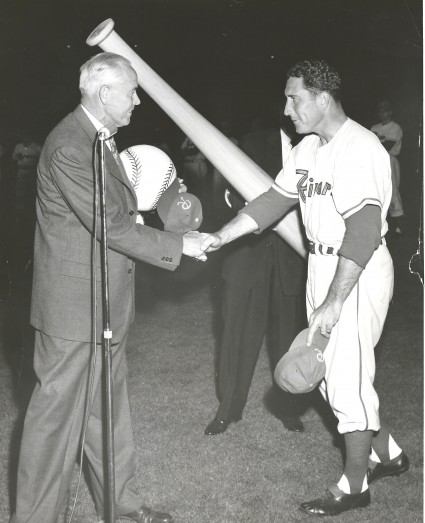
Jacked after Feslers dazzling, three-pitch whiff of Moran, a career .271 minor league hitter, the Sicks Stadium crowd of 13,999, babbling with excitement, whooped for more. But Fesler could not produce a storybook ending, the Moran strikeout becoming the highlight of Feslers day.
In fact, the rest of the game might as well have been written by Kafka. After Moran returned to the bench, Fesler, in succession, gave up a walk, a wild pitch, a single, a walk, a three-run double and another walk.
Finally, the San Francisco batters simply quit swinging and waited for Fesler to find the plate, which he could not. Feslers control, so spectacular from 46 feet, deserted him at 60 feet, six inches.
At 60 feet, 6 inches, he couldnt find the plate with a guide dog, opined The Times.
Fesler finally resorted to steering the ball, and one batter, in Feslers words, uncoiled a shot that I was afraid would tear the roof off the service station a block outside the ballpark.
Hutchinson brought out the hook after Fesler pitched just one-third of an inning, during which the Seals scored five times en route to a 5-3 victory.
Fesler got a chance at redemption in the second game of the doubleheader when Hutchinson brought him in as a reliever in the eighth inning, replacing starter John Oldham, who trailed 9-5. Fesler struck out two, including the hapless Moran again with the bases loaded, but also gave up four walks, three singles and a home run. He also cut loose three wild pitches.
Hell have to learn to get the ball over, said Hutchinson. They didnt him too hard, but the walks killed him.
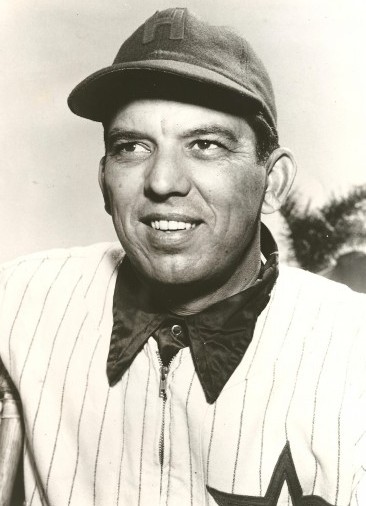
Tommy Heath, Seals manager, said the consensus among his players was that Fesler had real good stuff, if he could get it over. You cant win if you cant throw strikes.
There were times when the newcomer looked good, observed The Times. But they were separated by extended intervals of wildness. He needs considerable work on control, getting off the mound on infield grounders and holding runners on base. Thats on the docket for the rookie before he is ready to take his place among the starters. On the credit side, his ‘breaking stuff’ should be tough to hit if he succeeds in getting it over.
Fesler got into two more games for the Rainiers. Those, too, degenerated into nightmares. Not ready to give up on what became known as The Grand Experiment, the Rainiers farmed Fesler to a lower league.
But the 60-foot, 6-inch pitching distance proved an unconquerable obstacle and Fesler, though he gave it his best, floundered. He journeyed to spring training with the Rainiers in 1956, but was optioned to a California League team in Visalia, CA., a town surrounded by bean fields.
After Fesler suffered a sprained ankle, and the 60-feet, 6 inch-distance as elusive as ever, he quit and returned to Seattle. The Rainiers declared the Fesler experiment dead April 20, 1956, giving him his release. His PCL pitching line: 4 games, 2 starts, 7.2 IP, 0-2 record, 7 Ks, 11 BBs, 16.43 ERA.
It took Fesler two years of negotiating with softball authorities to re-gain his amateur status, but he didnt acquire much rust during the layoff. He joined a team sponsored by Renton Auto Parts Dealers, an entry in the Cascade Amateur League. Returning to the comfort of the 46-foot pitching distance, Fesler fanned 12 in his debut, a 4-1 win over the Hoover Larks.
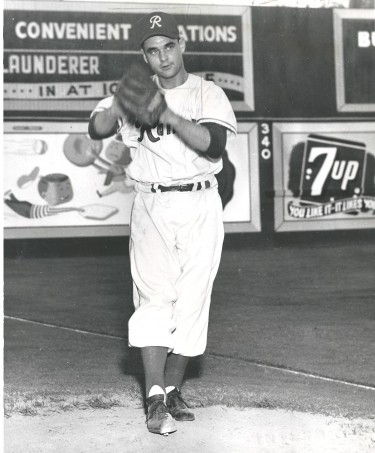
Pitching for Federal Old Line Insurance in 1958 (Fesler worked for the company, which entered a team in the league to showcase Fesler), Felser produced one of his better seasons, going 28-2 with four no-hitters.
On several occasions that year, Fesler threw four games in a single day, and over the next dozen years he did nothing but embellish his legend as one of the greatest softball pitchers produced in the Northwest.
Fesler never gained the national acclaim Eddie Feigner did on Feb. 8, 1967, Feigner appeared in a charity game and struck out Willie Mays, Willie McCovey, Brooks Robinson, Roberto Clemente, Maury Wills and Harmon Killebrew, all in a row but he became a local athletic celebrity, adding to it with performances such as these:
- July 12, 1961: Representing the Happy Hour Tavern, pitched a perfect game with 14 strikeouts and no walks in a 5-0 win over Red Fox.
- Aug. 26, 1965: Tossed a five-hitter with 23 strikeouts, leading Burke Sales to a 2-0 victory over the Dog House in 11 innings at White Center Stadium.
- June 24, 1967: Allowed three hits and fanned 15, hurling Lucky Lager to a 7-1 Major League Softball win over IGA at Lower Woodland.
- July 20, 1971: Pitching for Petschi’s Meats, threw a 4-0 no-hitter at Woodland Park, fanning 15 at the age of 41.
In 1978, the Greater Seattle Softball Association inducted Fesler into its Hall of Fame, but Fesler didnt take his enshrinement as any reason to quit.
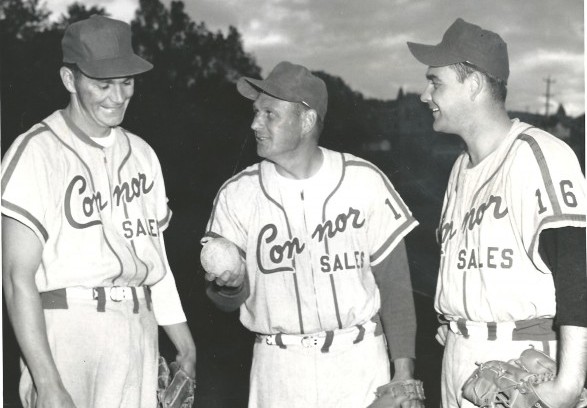
Instead, he joined Seattles Old Timers League and pitched for Mikes Chili Parlor and several other teams until early 1983, when a combination of an injury and his job as a swing-shift plumber at Boeing kept him off the mound.
Fesler died Aug. 29, 1983, at age 54, following complications from surgery that he underwent to stanch internal bleeding. Local softball officials immediately created the Bob Fesler Memorial Fastpitch Tournament at White Center Park, where Fesler threw more than a dozen no-hitters.
Before Fesler died, he said he never had any regrets about becoming a guinea pig in the Great Experiment with the Seattle Rainiers. In fact, Fesler said, the experience provided him a lasting momento: after the Rainiers won the 1955 PCL pennant, Fesler received a gold championship ring that he wore the rest of his life.
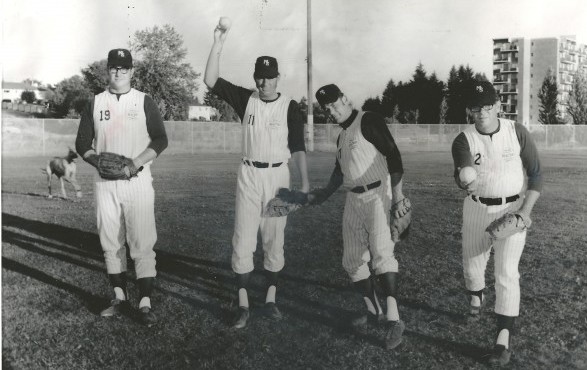
——————————————-
Many of the historic images published on Sportspress Northwest are provided by resident Northwest sports history aficionado David Eskenazi. Check out Davids Wayback Machine Archive. David can be reached at (206) 441-1900, or at seattlesportshistory@gmail.com

12 Comments
At 4 years old I vaguely remember “the great experiment” but at 61 I can say physics was it’s downfall. Sometimes things just don’t scale up. David, thanks for the flashback.
On behalf of David Eskenazi, thanks for taking the time to visit our web site and go down memory lane with us.
At 4 years old I vaguely remember “the great experiment” but at 61 I can say physics was it’s downfall. Sometimes things just don’t scale up. David, thanks for the flashback.
On behalf of David Eskenazi, thanks for taking the time to visit our web site and go down memory lane with us.
What a fabulous story. I love these trips down memory lane!
Doug: Thanks for taking the time to read. It’s a pleasure having you visit us.
What a fabulous story. I love these trips down memory lane!
Doug: Thanks for taking the time to read. It’s a pleasure having you visit us.
What a totally cool write-up, along with the usual great photos. I remember Bobby Fesler pitching in the 70’s, particularly in 1970 and 1971, when I followed Bill Fenton’s Pay’n’Pak team because there was no pro baseball in Seattle…Bill O’Mara used to call Pak games on the old KFKF radio station from White Center Stadium, and it was the first time I’d ever heard the “ping” of aluminum bats.
I really miss Major League fastpitch and Pak/Peterbilt Western/Seafirst players like Butch Batt, the Nokes brothers, Dick Christensen, Tom Wagner, Bill Stewart, Jimmy Moore, Billy Boyer, etc. You could catch a doubleheader in three hours and even though there were a LOT of 1-0 and 2-1 games, they were never boring because every hit meant something.
Thanks, Steve and Dave. You guys have done it again.
We do it, RadioGuy, because you continue to visit us. On behalf of Dave, thanks for reading.
What a totally cool write-up, along with the usual great photos. I remember Bobby Fesler pitching in the 70’s, particularly in 1970 and 1971, when I followed Bill Fenton’s Pay’n’Pak team because there was no pro baseball in Seattle…Bill O’Mara used to call Pak games on the old KFKF radio station from White Center Stadium, and it was the first time I’d ever heard the “ping” of aluminum bats.
I really miss Major League fastpitch and Pak/Peterbilt Western/Seafirst players like Butch Batt, the Nokes brothers, Dick Christensen, Tom Wagner, Bill Stewart, Jimmy Moore, Billy Boyer, etc. You could catch a doubleheader in three hours and even though there were a LOT of 1-0 and 2-1 games, they were never boring because every hit meant something.
Thanks, Steve and Dave. You guys have done it again.
We do it, RadioGuy, because you continue to visit us. On behalf of Dave, thanks for reading.